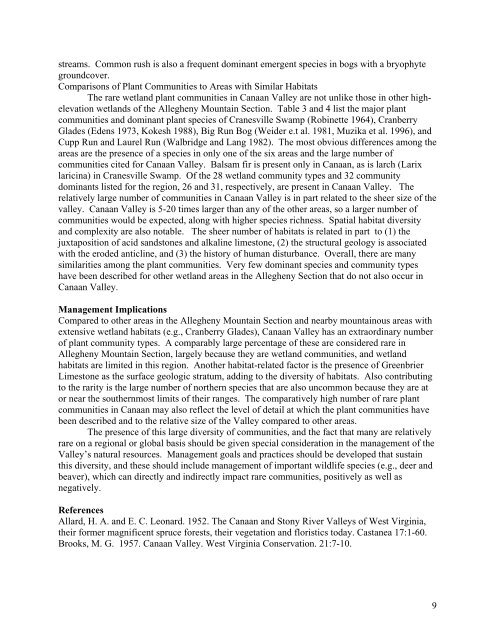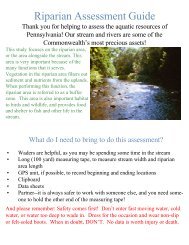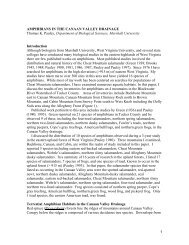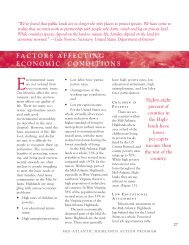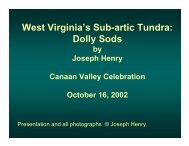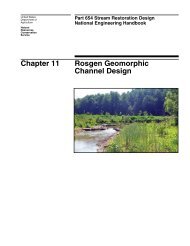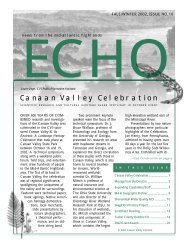rare plant communities in canaan valley, west virginia
rare plant communities in canaan valley, west virginia
rare plant communities in canaan valley, west virginia
Create successful ePaper yourself
Turn your PDF publications into a flip-book with our unique Google optimized e-Paper software.
streams. Common rush is also a frequent dom<strong>in</strong>ant emergent species <strong>in</strong> bogs with a bryophytegroundcover.Comparisons of Plant Communities to Areas with Similar HabitatsThe <strong>rare</strong> wetland <strong>plant</strong> <strong>communities</strong> <strong>in</strong> Canaan Valley are not unlike those <strong>in</strong> other highelevationwetlands of the Allegheny Mounta<strong>in</strong> Section. Table 3 and 4 list the major <strong>plant</strong><strong>communities</strong> and dom<strong>in</strong>ant <strong>plant</strong> species of Cranesville Swamp (Rob<strong>in</strong>ette 1964), CranberryGlades (Edens 1973, Kokesh 1988), Big Run Bog (Weider e.t al. 1981, Muzika et al. 1996), andCupp Run and Laurel Run (Walbridge and Lang 1982). The most obvious differences among theareas are the presence of a species <strong>in</strong> only one of the six areas and the large number of<strong>communities</strong> cited for Canaan Valley. Balsam fir is present only <strong>in</strong> Canaan, as is larch (Larixlaric<strong>in</strong>a) <strong>in</strong> Cranesville Swamp. Of the 28 wetland community types and 32 communitydom<strong>in</strong>ants listed for the region, 26 and 31, respectively, are present <strong>in</strong> Canaan Valley. Therelatively large number of <strong>communities</strong> <strong>in</strong> Canaan Valley is <strong>in</strong> part related to the sheer size of the<strong>valley</strong>. Canaan Valley is 5-20 times larger than any of the other areas, so a larger number of<strong>communities</strong> would be expected, along with higher species richness. Spatial habitat diversityand complexity are also notable. The sheer number of habitats is related <strong>in</strong> part to (1) thejuxtaposition of acid sandstones and alkal<strong>in</strong>e limestone, (2) the structural geology is associatedwith the eroded anticl<strong>in</strong>e, and (3) the history of human disturbance. Overall, there are manysimilarities among the <strong>plant</strong> <strong>communities</strong>. Very few dom<strong>in</strong>ant species and community typeshave been described for other wetland areas <strong>in</strong> the Allegheny Section that do not also occur <strong>in</strong>Canaan Valley.Management ImplicationsCompared to other areas <strong>in</strong> the Allegheny Mounta<strong>in</strong> Section and nearby mounta<strong>in</strong>ous areas withextensive wetland habitats (e.g., Cranberry Glades), Canaan Valley has an extraord<strong>in</strong>ary numberof <strong>plant</strong> community types. A comparably large percentage of these are considered <strong>rare</strong> <strong>in</strong>Allegheny Mounta<strong>in</strong> Section, largely because they are wetland <strong>communities</strong>, and wetlandhabitats are limited <strong>in</strong> this region. Another habitat-related factor is the presence of GreenbrierLimestone as the surface geologic stratum, add<strong>in</strong>g to the diversity of habitats. Also contribut<strong>in</strong>gto the rarity is the large number of northern species that are also uncommon because they are ator near the southernmost limits of their ranges. The comparatively high number of <strong>rare</strong> <strong>plant</strong><strong>communities</strong> <strong>in</strong> Canaan may also reflect the level of detail at which the <strong>plant</strong> <strong>communities</strong> havebeen described and to the relative size of the Valley compared to other areas.The presence of this large diversity of <strong>communities</strong>, and the fact that many are relatively<strong>rare</strong> on a regional or global basis should be given special consideration <strong>in</strong> the management of theValley’s natural resources. Management goals and practices should be developed that susta<strong>in</strong>this diversity, and these should <strong>in</strong>clude management of important wildlife species (e.g., deer andbeaver), which can directly and <strong>in</strong>directly impact <strong>rare</strong> <strong>communities</strong>, positively as well asnegatively.ReferencesAllard, H. A. and E. C. Leonard. 1952. The Canaan and Stony River Valleys of West Virg<strong>in</strong>ia,their former magnificent spruce forests, their vegetation and floristics today. Castanea 17:1-60.Brooks, M. G. 1957. Canaan Valley. West Virg<strong>in</strong>ia Conservation. 21:7-10.9


